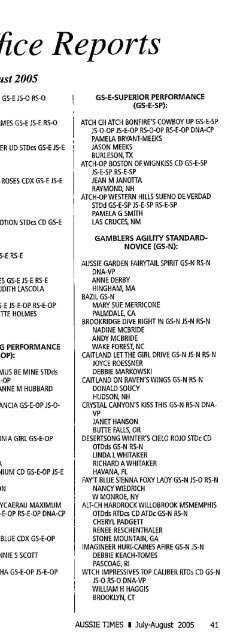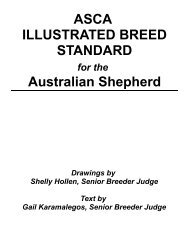Create successful ePaper yourself
Turn your PDF publications into a flip-book with our unique Google optimized e-Paper software.
Try not be caught off guard.<br />
You paid good money for<br />
that run. You owe it to<br />
yourself and your dog to<br />
be prepared.<br />
After one more check<br />
with the running order to<br />
make sure there are no<br />
last-minute scratches or<br />
move-ups, I will go to the<br />
practice jump and work<br />
on our warm-up routine.<br />
My routine varies with<br />
what class I'm about to<br />
run. If we are about to run<br />
gamblers, I work on "outs"<br />
and "sending". If we are<br />
about to run a tight jumpers<br />
course, I will work on<br />
attention work and wrapping tight around<br />
the jump. If I plan to do a lead-out, I will<br />
do several sit-stays. I tailor each warm-up<br />
to help us prepare for the challenges that<br />
lie in the upcoming course.<br />
I try to make my warm-up easy for my<br />
dog. The practice jump (or weaves) is not<br />
the place to work on training issues. Ifyour<br />
dog is having a training issue, you might<br />
not be ready to show, or you might have to<br />
readjust your expectations for the outcome<br />
of the run. (For example, if you ask for a<br />
skill three times at the practice jump and<br />
your dog doesn't succeed, your dog might<br />
not be ready for the challenge.) I want<br />
my dog to be confident and happy about<br />
working with me. So I start with someeasy<br />
skills to make my dog think he's brilliant.<br />
Then we work on the more difficult ones.<br />
I always end on a good note and keep the<br />
sessions no longer than a few minutes.<br />
Since I run multiple dogs, I often have<br />
to warm up several at the same time. Instead<br />
of giving the first dog a nice long warmup<br />
and yanking the rest out of their crate,<br />
I work with all of them before the class. I<br />
potty and walk them all together. Then I<br />
usually ask people sitting ringside to hold<br />
one while I work the others. Some people<br />
crate ringside and don't have this problem.<br />
I prefer to crate my dogs in my car when<br />
possible. I feel that it is less stressful to be<br />
in a quiet and familiar place than sitting<br />
ringside with all the commotion going on.<br />
It does require that I walk back and forth<br />
more though.<br />
With good planning and some luck,<br />
my dog and I are prepared to run when it<br />
is our turn. IfI have to wait for a few dogs<br />
Agility Matters<br />
A warni-up routine will loosen the dog's muscles to help avoid injuries.<br />
before me, I will stand near the in gate and<br />
ask my dog to do tricks. I want to keep<br />
his attention focused on me and keep his<br />
mind on working. I also keep my attention<br />
focused on my dog. It's the least I can do if I<br />
require that he focus on me. I do not use this<br />
opportunity to talk to my friends about the<br />
course. I don't want to lose the connection<br />
with my dog that I have just built.<br />
If you are<br />
consistent with your<br />
warm-up and cooldown<br />
routines, your<br />
dog will begin to<br />
understand when<br />
it's time to pay<br />
attention and when<br />
he's allowed to visit.<br />
When it's ourtum, I enter the ring, take<br />
a deep breath, and start my run. If things<br />
don't go as planned, I try to make a mental<br />
note for training ideas. (This includes my<br />
handling skills as well!)<br />
When the run is finished and my dog<br />
is on leash again, we immediately run to<br />
get a treat. If we didn't qualify but most<br />
of the course was nice, I still give my dog<br />
a reward. I always reward my dogs for<br />
trying regardless of the outcome. I want<br />
them to like going into the ring. One of<br />
my pet peeves are handlers whose dog<br />
tried hard on course and the<br />
handler doesn't acknowledge<br />
it until after they discussed<br />
the run in detail with all their<br />
friends. If the reward comes<br />
several minutes after the<br />
performance, how will the<br />
dog know that running the<br />
course earned him a cookie?<br />
Dogs benefit from consistent<br />
and immediate feedback.<br />
If my dog didn't try at<br />
all and wasn't "there", I get<br />
the cookies and return to the<br />
practicejump. I ask my dog to<br />
do a few easy things requiring<br />
his attention and then give him<br />
the reward. I always want my<br />
dog to be successful but once<br />
in awhile, it takes some creativity. If I have<br />
an occasional disasterous run, I just chalk<br />
it up to "stuffhappens". But if disasterous<br />
runs become the norm, then most likely<br />
there is a hole in my training and I need to<br />
address the problems at home before this<br />
dog is ready to return to the ring.<br />
If I am running multiple dogs, I<br />
will switch dogs after the current one<br />
has received his reward. I don't put the<br />
dogs back into their crates immediately<br />
following their run, though. Once all of<br />
my dogs have run in a particular class, I<br />
take all ofthem on a walk to cool down. A<br />
walk helps their muscles stay loose and gets<br />
rid of any lactic acid buildup. Also, it's a<br />
nice treat for a job well-done in the ring.<br />
If possible, after the walk, I will sit<br />
quietly with my dog(s) and give them a<br />
little massage or just let them hang out.<br />
Then I return them to their crates where<br />
they can rest until the next run.<br />
If you are consistent with your warmup<br />
and cool-down routines, your dog will<br />
begin to understand when it's time to pay<br />
attention and when he's allowed to visit.<br />
However, you must be consistent when<br />
you require attention versus when the<br />
dog is allowed to just relax. In addition,<br />
by having times during the trial when all<br />
your attention is focused on your dog, you<br />
can continue to build your relationship.<br />
And finally, warming up and cooling<br />
down can help avoid injuries and extend the<br />
competitive life ofyour canine athlete.<br />
82 AUSSIETIMES I <strong>July</strong>-<strong>Aug</strong>ust <strong>2005</strong>



